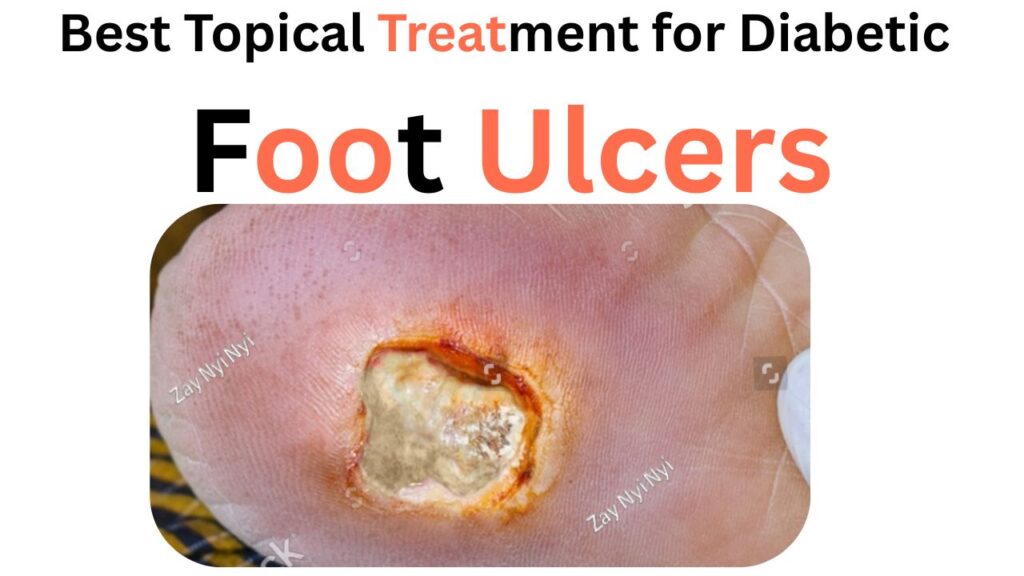Diabetes is among the world’s growing health issues. High blood sugar is a disease that millions have, and, unfortunately, many develop significant complications when poorly controlled. Diabetic foot ulcers are one of the most frequent and serious complications. These open wounds. Best topical treatment for diabetic foot ulcers
A tiny laceration, blister, or shoebite does not seem life-threatening, but for a diabetic patient, it can turn into a chronic whining wound. This is further exacerbated by weak immunity, poor blood circulation, and nerve damage; thus, the healing process becomes very challenging. Without timely treatment, those types of wounds can become infected seriously, requiring hospitalization or even amputation in the worst case.
This article will help you understand everything you need to know about diabetic foot ulcers including their causes, symptoms, prevention and treatments. And most important, we will be focusing on healing creams and foot care products that can help accelerate the recovery as well as create a protective barrier on skin. We are committed to providing the highest quality service at all levels.
Table of Contents
Best topical treatment for diabetic foot ulcers
What causes Foot Ulcers in diabetic Patients?
The diabetic foot ulcer is not simply a skin lesion. It is a symptom of a few underlying issues with blood sugar levels being too high. Let’s understand the key reasons:
Reduced Circulation (Peripheral Vascular Disease)
Elevated blood glucose destroys blood vessels and shrinks arteries. Reduced blood supply means that the transport of oxygen and nutrients to the wound area is limited. If there is not enough blood flow, wounds are not going to heal as fast.
Nerve Damage (Diabetic Neuropathy)
Diabetes can destroy the nerve endings in the gave, resulting in loss of sensation of pain, heat or injury. This implies that an individual might even have a blister, shoe bite, or cut, but will not even realize it. After they know, the infection might arrive.

Weak Immune System
High blood sugar affects white blood cells, which otherwise could fight infections. As a result, the body heals slower and cannot fight the bacteria.
Dry Skin and Cracks
Diabetes often leads to dry skin, followed by itching and cracking. When the skin on the feet gets dry and then cracks, it can allow bacteria to penetrate the tissue and cause infections. It can also result in the formation of ulcers.
Foot Deformities and Pressure Points
Bunions, hammertoes, or flatfeet shift the pressure while walking and cause constant pressure points and skin breakdown leading to ulcer formation.
Common Symptoms of Diabetic Foot Ulcers
Foot ulcers might develop from a small sore or blister, and soon it gets worse becoming a severe wound. The symptoms include :
open wound appearing persistently on any part of the foot or the toes
swelling, redness, or warmth on and around the wound
discharge of pus or fluid, causing a bad smell
Wound edges turning dark and surrounding skin becoming dead
Numbness or tingling sensation around the feet
Pain sensation, however, might be absent or very mild, especially to patients who have developed neuropathy.
Complications If Ignored.
Leaving diabetic foot ulcers untreated puts your life in danger. Some of the complications associated with ignored foot ulcers include:
Cellulitis: Skin infection
Osteomyelitis: Bone infection
Gangrene: Tissue death due to lack of good blood flow
Foot amputation itch
: in extreme and uncontrollable cases
It is important to treat diabetic foot ulcers on-time. Always ensure you consult your doctor in such circumstances. Moreover, advanced ulcers require more costly treatments compared to early ones.
Role of Healing Creams in Diabetic Foot Care
Healing creams do not simply contain sugars to moisten the skin. They contain essential components to do the following:
Keep the skin moistened and thus prevents cracking
Improves blood flow of the skin
Act as an antiseptic and antifungal agent
Relieves pain and itchiness
Regenerates fresh tissue and tones the existing one
Resists against the further penetration of chemicals from the air and surroundings
Applying the right cream can accelerate wound healing.
Main Components of the Diabetic Foot Healing Creams
Patients should look at the list of ingredients when purchasing a cream Here is the science behind what helps.
l-arginine → Helps blood flow and tissue recovery
Lactic Acid → Helps to slough away dead skin cells and soften hardened skin
Apple Cider Vinegar → Acts as a mild antibacterial and antifungal protector.
Tea Tree Oil → An essential antiseptic, can kills bacteria and fungi.
Hydrates And Softens Dry, Cracked SkinUrea →
SHEA BUTTER → Intensive healer for traumatized skin.
Aloe Vera → Calms inflammation and helps wounds heal.
Silver Nanoparticles / Silver Sulfadiazine → bactericidal and prophylaxis of infections in deeper wounds.
Foot Care For Diabetic Patient In Steps
A basic daily care routine can help keep the ulcers at bay and expedite the healing of wounds:
Daily Footwash → with gentle soap in warm water Avoid very hot water.
Dry Well → Use a towel to gently blot your feet; do not rub, park yourself gently, Pad gently between your tootsies.
Moisturize → Apply diabetic foot cream every day but do not cream in between toes (may cause a fungal infection).

Check Feet → For cuts, redness, blisters, or swelling.
When trimming the nails Cut across, not too short (Avoid ingrowing nails)
Footwear → Comfy Shoes → Soft-well fitted soft shoes relieve pressure and friction.
Wear Cotton Socks → change every day, ensure dry feet
Never Walk Barefoot → Do not walk barefoot even at home to minimise the risk of injuries.
Quick Heal: 6 Lifestyle & Diet Changes For Fast Recovery
Control blood sugar (the most important thing).
Focus on Vitamin C, Zinc, and Protein – to support healing.
Stay hydrated.
Say no to smoking (decreases blood flow)
Exercise moderately (walking improves circulation but avoid pressure on wounds)
Natural Ways That Can Aid In Recovery
So, you will still need some medical creams but here are few natural treatments to assist the healing process:
Aloe Vera Gel → For small cuts and to cool and moisturize
Turmeric paste it is a good antifungal( but only for times when you can just stay in house)
Honey Dressings → Studies show that honey has wound healing effects.
Neem Oil → Inhibits Bacteria and Fungus
⚠️ Note: These should only be supplementary home remedies. Medical Creams and Doctor Supervising for Open Ulcers
- Medical Treatments Beyond Creams
- When creams alone don’t do the trick, docs will suggest:
- Antibiotics (for infected wounds)
- Special dressings for wounds (hydrogel, dressing sponges, silver fibres)
- Debridement (removal of dead skin and tissue)
- Skin grafting (for large ulcers)
- Hyperbaric Oxygen Therapy (to boost oxygen supply)
- Surgery (in severe cases)
- Prevention of Diabetic Foot Ulcers
These words fit perfectly for a diabetic foot problem as “prevention is better than cure” in particular.
- Keep blood sugar well-controlled.
- Follow daily foot care routine.
- Maintain a regular follow-up with a podiatrist (foot specialist).
- Never ignore minor wounds.
- Apply protective creams and moisturizers every day.

Frequently Asked Questions (FAQ)
What is the ointment for diabetic foot ulcers?
An effective cream would include ingredients like urea, tea tree oil, or silver sulfadiazine. Brand selection is subject to availability depending on the country.
Is it Possible to Cure Diabetic Ulcers with Home Remedies?
No. They could help healing but need medical attention.
How long should it take for a diabetic foot ulcer to heal?
Wound size and control of blood sugar remain to be the determining factor. They may take 3–4 weeks to heal if they are small, and much longer if the ulcer is big.
When should I see a doctor?
When the wound fails to heal, appears infected, malodorous, or extremely painful
Conclusion
Diabetic foot ulcers, if not managed on time with the right creams and lifestyle changes, are a significant health risk.
Always check your feet daily.
Expect a diabetic-friendly healing cream: urea, L-arginine, and tea tree oil.
But maintain your propensity for sugar.
Don’t take minor abrasions or lacerations lightly.
By taking precautions and acting quickly, people with diabetes can safeguard their feet—and their right to enjoy a full, active life.
Diabetic Foot Ulcers and Healing Creams: A Complete Guide for Patients and Caregivers.
Hello everyone, I am Md Habibullah Sheikh a registered Pharmacist with 6 years of experience in Clinical, Community, and corporate pharmacy. I have worked for HLFPPT, Gauripur Hospital, Reliance Retail Pharma (Netmeds) as well and Now working for Zota Health Care as a Senior Pharmacist. We, In Health Easy Fitness, share trustable health education, tips & awareness to help people find the best health choice. Always talk to a doctor before taking any kind of Health issue Decision.
